|
The
Last Salute: Civil and Military Funeral, 1921-1969
CHAPTER XIX
General of the Army George C. Marshall
Special Military Funeral
16-20 October 1959
General of the Army George C. Marshall died at Walter Reed General
Hospital on 16 October 1959 at the age of seventy-eight. By virtue of
his former positions as Chief of Staff of the Army and as Secretary
of Defense, General Marshall was entitled to a Special Military Funeral
and, as a former Secretary of State, he was entitled to the more elaborate
honors of an Official Funeral. He received a Special Military Funeral,
but in keeping with his known wishes and with what has been described
as his "Spartan concept of propriety," the rites for General
Marshall were among the simplest ever conducted for a man of his rank
and prestige.
The Commanding General, Military District of Washington, Maj. Gen. Charles
K. Gailey, was responsible for arranging the ceremonies. Through an
officer of his staff appointed as aide to the next of kin, General Gailey
worked closely with Katherine T. Brown Marshall, the general's widow,
to see that all of her husband's and her own wishes were met.
According to the plan worked out, General Marshall's body was to lie
in Bethlehem Chapel at the Washington National Cathedral for twenty-four
hours, beginning at noon 19 October. On the 20th, the general's body
was to be taken to the post chapel at Fort Myer, Virginia, for the funeral
service, which would be attended by a limited number of invited guests.
A private burial service in Arlington National Cemetery was to follow.
The gravesite, in Section 7, a little to the east of the Memorial Amphitheater,
had been selected by General Marshall some years earlier and already
contained the grave of the general's first wife, Elizabeth Coles Marshall,
and her mother.
On the day of the general's death, President Dwight D. Eisenhower issued
a proclamation ordering the flag flown at half-staff on all public buildings
except the Capitol, at all military posts and naval stations in the
United States, and at American facilities abroad. The flag was to be
so displayed until after the burial service.
On 17 October General Marshall's body was moved from Walter Reed General
Hospital to the S. H. Hines Funeral Home, where it remained until 19
October. A half an hour before noon on the 19th, the commander of the
Military District of Washington, General Gailey, accompanied by Armed
Forces Police and
[157]
Metropolitan motorcycle police, arrived at the funeral home to escort
the general's body to the Washington National Cathedral. The casket
had already been placed in a hearse, and at 1145 General Gailey started
the small motorized cortege toward the cathedral. Motorcycle police
led the way, followed by Armed Forces Police, the escort commander,
the hearse (accompanied by a mortician), and at the rear another Armed
Forces Police car.
A few minutes before noon the military units taking part in the cathedral
ceremonies were in position at the entrance to the Bethlehem Chapel.
A joint honor cordon lined the walkway and entrance steps; a national
color detail and personal flag bearer stood near the cordon; and the
body bearers waited at the street end of the walkway. The body bearers
included an enlisted man each from the Army, Marine Corps, Navy, Air
Force, and Coast Guard and one cadet from Virginia
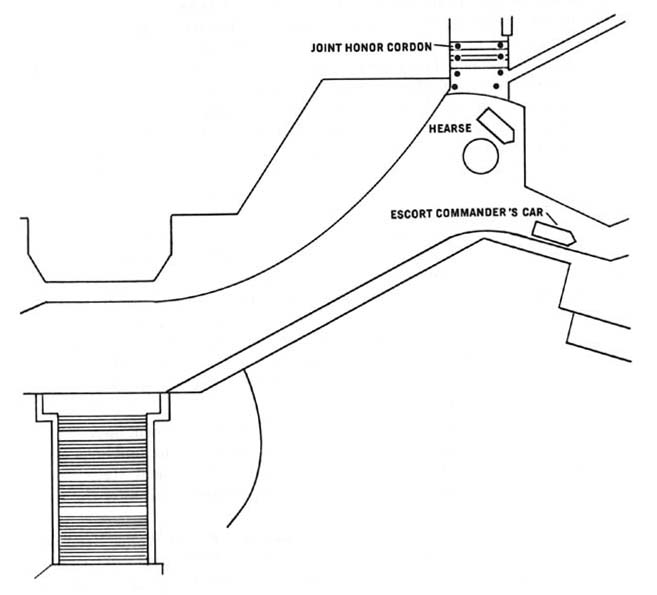
Diagram 43. Arrival ceremony, Washington National Cathedral.
[158]
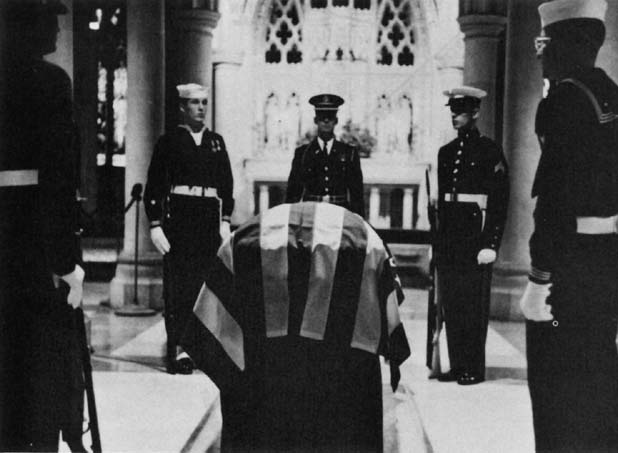
JOINT HONOR GUARD STANDS WATCH IN BETHLEHEM CHAPEL
Military Institute, General Marshall's alma mater. This same body bearer
detail would participate in ceremonies at the cathedral and in the graveside
service on 20 October. A second team of body bearers of the same composition
would participate in the funeral service at Fort Myer. With the body
bearers at the chapel walkway were two members of the clergy: Canon
Luther D. Miller of the Washington National Cathedral, a long-time friend
of General Marshall's and a former Army Chief of Chaplains, and the
Reverend Franklin Moss, Jr., of General Marshall's home church, St.
James Episcopal, in Leesburg, Virginia. Inside the cathedral, a joint
guard of honor was ready to post its first relief around the casket
after it was placed in the Bethlehem Chapel.
When the cortege arrived the hearse stopped in front of the chapel entrance.
(Diagram 43) The body bearers and clergy then moved to the rear
of the hearse, and the color teams took station nearby. The escort commander
meanwhile took his place at the chapel entrance.
The honor cordon presented arms as the body bearers removed the casket
from the hearse. Then, preceded by the escort commander, the clergy,
and the national color detail, and followed by the personal flag bearer,
General Marshall's
[159]
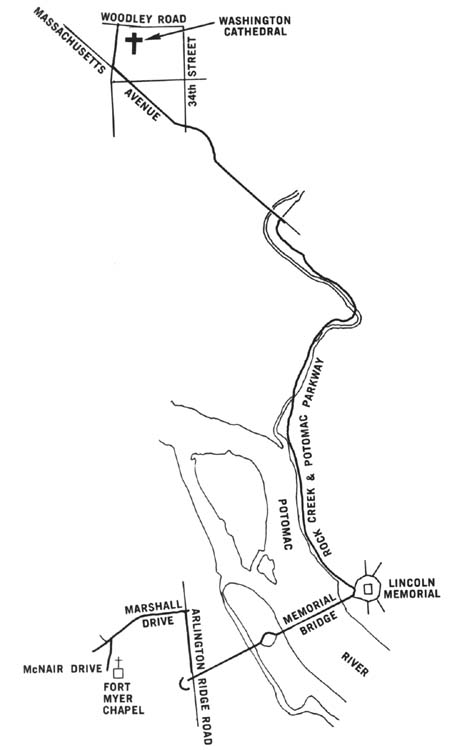
Diagram 44. Route of march, Washington National Cathedral to Fort Myer
Chapel.
[160]
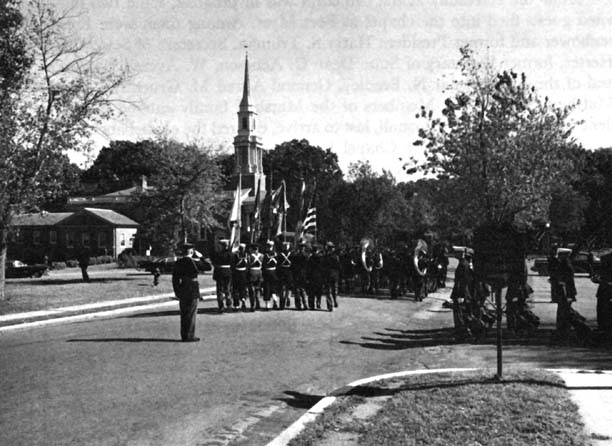
ARMED FORCES HONOR GUARD APPROACHES THE CHAPEL
casket was borne through the honor cordon into the chapel, where it
was placed on a catafalque. The colors were posted without guards. The
first relief of the guard of honor then entered the chapel, whereupon
the guard commander dismissed the body bearers and posted his sentinels
around the casket. General Marshall's body remained in the Bethlehem
Chapel which the public was permitted to enter to pay respects until
noon on 20 October.
At 1400 on the 20th, the general's body was taken from the cathedral
for the movement to Fort Myer in a ceremony conducted by the same formation
that had attended the arrival at the cathedral. Again the joint honor
cordon formed along the steps and walkway outside the Bethlehem Chapel.
The honor cordon saluted as Canon Miller and the Reverend Mr. Moss,
followed by the national color detail, the body bearers with the casket,
and the personal flag bearer, came out of the cathedral and moved to
a hearse on the street. After the body bearers placed the casket in
the hearse, General Gailey, the escort commander, and the clergy entered
their vehicles (a mortician again was with the hearse), and the small
cortege, accompanied by Metropolitan and Armed Forces Police, started
for Fort Myer. (Diagram 44)
[161]
While the ceremony at the cathedral was in progress, some two hundred
invited guests filed into the chapel at Fort Myer. Among them were President
Eisenhower and former President Harry S. Truman, Secretary of State
Christian A. Herter, former Secretary of State Dean G. Acheson, W. Averell
Harriman, General of the Army Omar N. Bradley, General Alfred M. Gruenther,
and General Matthew B. Ridgway. Members of the Marshall family entered
after the President was seated; Mrs. Marshall, last to arrive, entered
the chapel about 1425.
Outside the Fort Myer Chapel fourteen honorary pallbearers lined the
entrance walkway: General Lyman L. Lemnitzer, Robert A. Lovett, General
Wal
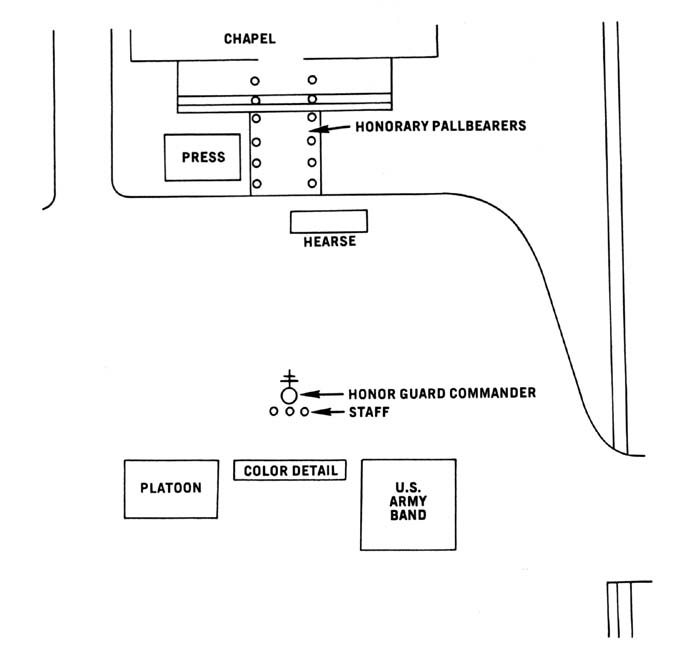
Diagram 45. Formation at Fort Myer Chapel.
[162]
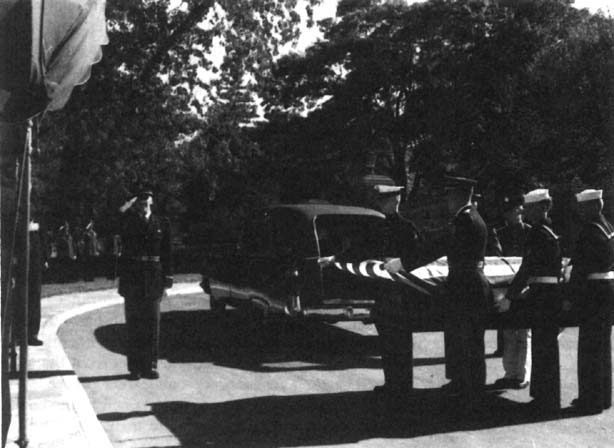
CASKET IS CARRIED INTO THE CHAPEL
ter Bedell Smith, Robert Woods Bliss, James Bruce, Admiral Harold R.
Stark, General Charles D. Herron, Brig. Gen. Frank McCarthy, Col. Robert
H. Fletcher, Col. William M. Spencer, Donald Cook, Lt. Col. Clarence
J. George, M. Sgt. James W. Powder, and M. Sgt. William J. Heffner.
In formation across the street from the entrance was an armed forces
honor guard commanded by an Army captain with a staff of three: a lieutenant,
junior grade, from the Navy, a lieutenant, junior grade, from the Coast
Guard, and an Air Force lieutenant. The formation included the U.S.
Army Band, an armed forces color detail, and an armed forces platoon
of three squads. The color detail was made up of one color guard each
from the Army and Marine Corps, two Army color bearers, one for the
national colors and one for the Army colors, and one color bearer from
each of the other services with the appropriate service colors. The
armed forces platoon was commanded by a Marine Corps lieutenant. Each
squad in the platoon had ten men, two each from the Army, Marine Corps,
Navy, Coast Guard, and Air Force. One of the Army men in each squad
was the leader. (Diagram 45)
The arriving motorcade halted on the street between the honor guard
and Fort Myer Chapel, the hearse coming to a stop near the chapel entrance.
After
[163]
the clergy and body bearers had taken their positions at the rear of
the hearse, the honor guard troops presented arms and the Army Band
sounded ruffles and flourishes and played the "General's March."
When the band began the hymn "Faith of Our Fathers," the body
bearers removed the casket from the hearse. Canon Miller and the Reverend
Mr. Moss then led the way through the cordon of honorary pallbearers
to the chapel entrance. At the entrance the body bearers placed the
casket on a movable bier, and from that point two of the bearers moved
the casket, following the clergy, to a position at the front of the
chapel. The honorary pallbearers then entered the chapel and took their
seats.
Canon Miller conducted the funeral service from the Episcopal Order
for the Burial of the Dead. There was no eulogy. At the conclusion of
the twenty-minute service, the honorary pallbearers, led out of the
chapel by General Bradley, reformed their cordon at the entrance. Two
body bearers meanwhile had moved to the front of the chapel to handle
the casket. The clergy then led the funeral party from the chapel. President
Eisenhower left the chapel by a side entrance. When the clergy reached
the front entrance, the honor guard troops, who had remained in formation
across the way, presented arms; the band sounded honors, then began
a hymn. During the hymn the body bearers lifted the casket from the
movable bier and returned it to the hearse. The honorary pallbearers
proceeded to their cars. The members of the Marshall family, who had
remained at the chapel entrance while the casket was placed in the hearse,
went to their cars, and the
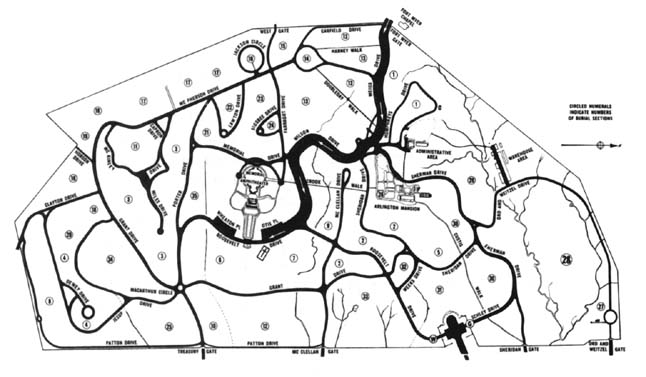
Diagram 46. Route of march, Fort Myer Chapel to gravesite.
[164]
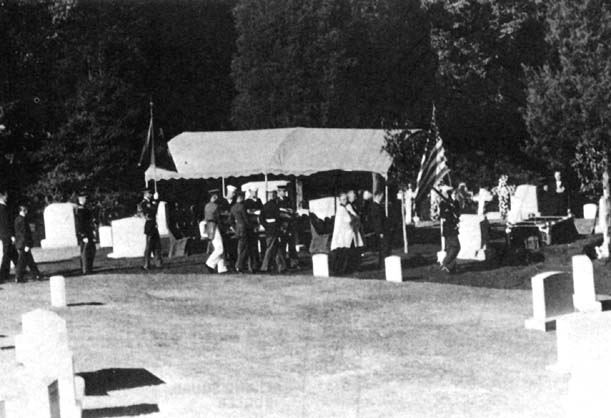
CASKET IS CARRIED TO THE GRAVE, above.
LAST RITES AT THE GRAVESITE, below.
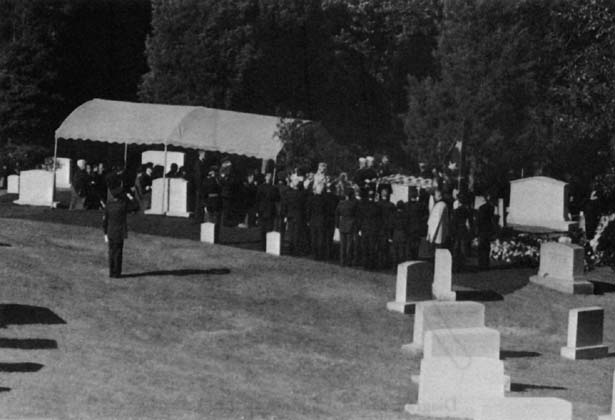
[165]
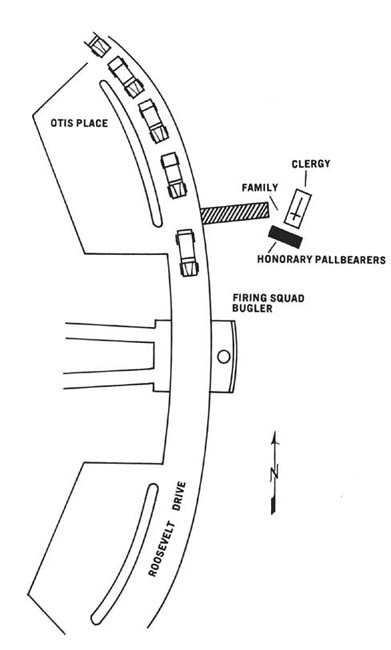
Diagram 47. Formation at the graveside.
[166]
small cortege of eight vehicles formed and moved toward the gravesite.
The other mourners then dispersed.
Since early afternoon, a security cordon of troops from the 3d Infantry
had been on station around the gravesite. A principal duty of these
troops was to keep members of the press and the public at least 150
feet away from the gravesite in order to ensure the privacy of the burial
service. Also in position some time before the cortege left the chapel
were the saluting battery of the 3d Infantry, a firing squad, a bugler,
the national color detail, the personal flag bearer, and the body bearer
team. The members of the body bearer team were those who earlier had
participated in the ceremonies at the Washington National Cathedral.
The body bearers who handled the casket at the Fort Myer Chapel did
not accompany the cortege to the gravesite.
The small procession, in order of march, included Mr. John C. Metzler,
superintendent of Arlington National Cemetery; General Gailey, escort
commander; the honorary pallbearers; the clergy; the hearse (accompanied
by a mortician) ; the Marshall family; and a second cemetery representative.
To reach the gravesite, the motorcade moved via Meigs Drive, Wilson
Drive, and Roosevelt Drive. (Diagram 46) It came to a halt so
that the rear of the hearse was aligned with a mat that had been laid
from Roosevelt Drive east to the grave.
The honorary pallbearers, first to leave their cars, formed a cordon
along the mat. The members of the Marshall family got out next and stood
while the clergy, body bearers, national color detail, and personal
flag bearer took positions at the rear of the hearse. When all were
in place, the body bearers removed the casket from the hearse. Then,
in procession, the national color detail, mortician, clergy, body bearers
with the casket, and personal flag bearer moved through the cordon of
honorary pallbearers to the grave. As the casket passed by, the honorary
pallbearers fell in behind and moved to their graveside position.
The Marshall family was escorted to the graveside by the cemetery superintendent.
(Diagram 47)
The clergy then conducted the burial service. At its conclusion, the
battery fired a 19-gun salute, the firing squad discharged the traditional
three volleys, and the bugler sounded taps. As the sound of the bugle
died away, the body bearers folded the flag that had draped the casket,
and one of them, the cadet from Virginia Military Institute, presented
the flag to Mrs. Marshall, thus concluding the simple rites for General
Marshall. Mrs. Marshall placed a small bouquet of flowers on her husband's
casket and left the graveside.
[167]
Previous Chapter
Next Chapter
|










